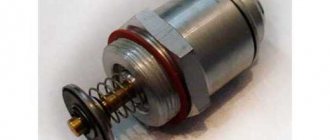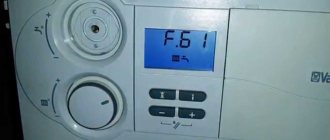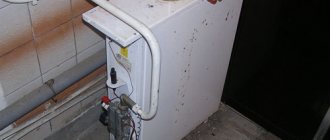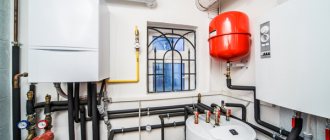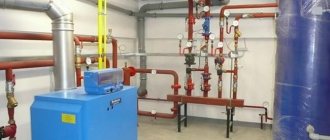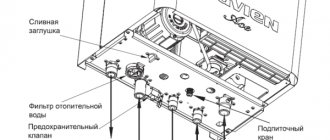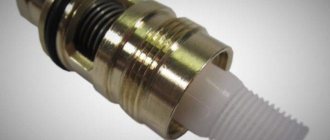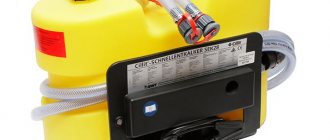Any manufacturer of gas heating equipment tries to limit consumer access to the design of the device as much as possible. In this way, the number of possible accidents is reduced. Professional gas boiler repair requires experience. The customer service department is reluctant to share information - this is their main source of income. Therefore, there is not much information about the causes of malfunctions.
However, it is possible to repair gas boilers on your own, but provided that you have an understanding of the problem that has arisen and experience working with your own hands.
Brief information about the system design
Gas boilers are divided into single-circuit and double-circuit according to the method of preparing hot water. The first type is used to heat the coolant circulating in the heating circuit. The second type is more complex in design - in addition to maintaining the heating system, the device heats water for the kitchen and bathroom. Therefore, if you master the repair of double-circuit gas boilers, then troubleshooting a single-circuit heating system will not become a problem.
A gas heating boiler consists of the following components:
- Housing with a pipe for removing gas combustion products. Inside it there is a frame or metal panel to which the main components of the gas boiler are attached.
- Combustion chamber. It contains a gas burner and a heat exchanger in which the coolant water is heated.
- A circulation pump that pumps coolant through a heat exchanger in the firebox.
- Gas and water supply control system with a set of sensors and a three-way valve.
- Electronic control board and flame ignition unit with thermocouple.
Double-circuit gas boilers additionally have a second heat exchanger for preparing hot water. It can be bithermal and heat running water using coolant energy, as, for example, in Ariston models.
Some boilers use an additional heat exchanger to heat water, built into the firebox and heating the water in the built-in boiler. For example, in Baxi brand equipment.
Wall-mounted boilers differ in the design of the firebox - it can be open, otherwise atmospheric, or closed. In the first case, air enters the combustion chamber due to the draft in the chimney pipe. In the second, the air flow is supplied using a smoke exhauster or an electric fan.
How to determine the need for cleaning
Gas boiler cleaning
Boiler manufacturers recommend servicing equipment once every 1 to 2 years. But the need for cleaning may arise more often, since it all depends on the operating conditions and the specific model. Most often, the heat exchanger needs unscheduled maintenance.
Expert opinion
Grebnev Vadim Savelievich
Heating system installer
When using low-quality water, the heat exchanger can become seriously scaly in just a few months. Boilers with atmospheric burners become covered with soot. Operating all models in dusty rooms leads to clogging of the igniter and burner.
But you shouldn’t disassemble the boiler on schedule just because it’s time for cleaning. In order not to take unnecessary actions, it is important to know the signs of clogging of internal parts and systems:
- slow heating;
- loss of power;
- increased gas consumption;
- pops when igniting;
- constantly working burner;
- extraneous noise during water movement;
- uncharacteristic odors from the boiler;
- difficult ignition;
- reduction of pressure in the water circuit;
- incorrect sensor readings;
- no reverse thrust.
The boiler should be inspected if at least one of these signs appears. But most often, several symptoms of contamination of parts are observed at once.
What you need to know about the operation of a gas boiler for successful repairs
The vast majority of modern heating devices using gas are made with a closed chamber and air intake from the street. In this case, the body of the gas boiler is placed on the wall, the distance from the floor should be at least 70 cm. This arrangement simplifies control and maintenance. Combustion products are discharged through a chimney in the wall. Repair of wall-mounted gas boilers is carried out in more comfortable conditions.
Old floor-standing boilers were previously installed on the floor under the window opening. Such systems operated according to gravity flow, without a pump and an additional hot water heat exchanger. They could function even in the absence of electricity. The burner operated in constant mode, the water was heated to 90-95 ℃. Gas fuel was burned with low efficiency. The repair was not the most pleasant thing - due to air locks, the heat exchanger could become clogged with soot and burn out.
Modern wall-mounted gas boilers operate primarily in pulse mode. This scheme allows you to accurately dose the amount of gas without overheating the heat exchanger. In addition, the presence of a pump allows you to “remove” more energy from the heat exchanger. But the presence of electrical valves, fans and electronic control boards complicates repairs.
The latest generation gas boilers are equipped with push-button, but more often touch control. Water temperature, pressure, and most importantly, an error code, in case of problems, is displayed on the LCD screen.
For example, in Vailant boilers, in order to obtain information, you need to press two buttons on the control panel - “i” and “+”. We press both at the same time, “d.0” appears on the screen with a list of possible problems. We move through the list, select the option that matches the description and press “i”, after which information on the problem that has arisen is displayed.
Information on Ariston can be taken from the table.
Models released more than 15 years ago had toggle switch controls and one or two dial indicators showing the temperature and pressure of the water in the system. Repair of old boilers was somewhat simplified, since there was no electronic display unit.
On the other hand, if a boiler such as Proterm “Lynx” needs to be repaired, then, regardless of the level of damage, this should only be done by a certified specialist. Condensing models are difficult to set up and even more difficult to repair.
Causes of breakdowns
If a gas boiler has worked without any comments or minor repairs (for example, replacing a handle or board retainer) for at least one year, then overall the product can be considered of high quality. Counterfeits and refurbished devices usually begin to fall apart within six months.
Therefore, if the boiler is original, purchased from an official dealer, and has undergone pre-start preparation and adjustment, two circumstances may cause the breakdown and subsequent repair.
Namely:
- problems with the quality of water, gas or electricity supply;
- hidden defects and flaws made during the installation of a gas boiler.
Service technicians tend to add one more reason to the list - improper operation of gas equipment, including unlawful interference with the operation of boiler units.
If the gas boiler is under warranty, then any attempt to “work” with the boiler automation will be detected by the service technician during the first service or repair.
Poor water quality
There may be two problems. The first is the high content of magnesium and calcium salts, due to which limescale deposits are deposited on the inner walls of the heat exchanger and pressure sensor.
In hard water conditions, craftsmen usually recommend adhering to two rules to avoid costly repairs:
- operate the gas boiler at a third of power - hot water in the secondary heat exchanger should not heat above 60 ℃. At this temperature, the rate of lime deposition decreases by an order of magnitude;
- periodically take the heat exchanger to a service center for washing.
If the heat exchanger burns out or leaks, then repair comes down to replacing the part or soldering the fistula. You can solder the secondary heat exchanger yourself; repairs to the primary heat exchanger should only be carried out by a specialist, using pressure testing.
Secondly, water may contain a large number of tiny abrasive particles that are not captured by the mud filter. This is usually iron oxide, which “eats” the plastic impeller of the circulation pump. To avoid repairs, you have to install a high-quality magnetic filter at the gas boiler inlet.
Power supply quality
Electronically controlled gas boilers are too sensitive to voltage surges in the electrical network. As a result, the ignition board and the electronic control unit for operating modes fail.
On old gas boilers 10-15 years old, the board and unit can be repaired with your own hands; on new models with digital control, repairs are carried out by replacing non-functioning elements.
Incorrect installation of equipment
One of the reasons for the breakdown of a gas boiler may be violations committed during installation. For example, for a wall-mounted model with a chimney outlet through the wall, according to the instructions, the chimney should be installed with a negative angle of 5° to the horizontal axis.
If the installation conditions are violated, then condensation will accumulate inside the sandwich chimney, which should flow down the pipe to the street. As a result of improper installation, moisture seeps into the combustion chamber. After a year of operation, repairs to the heat exchanger and gas burner of the boiler will be required.
Another violation is related to the lack of grounding. As a result, repair or replacement of the touch control unit will be required.
Failure to comply with operating conditions
Often the cause of repairs is problems associated with improper operation of boiler equipment.
The most common cases:
- Connecting a gas boiler to an outlet without a surge protector. In this case, a refrigerator, washing machine, or electric oven, when turned on, creates a surge in current and voltage in the network. As a result, repair of the control unit will be required.
- Installation and connection of a gas boiler via uninterruptible power supply. Not all uninterruptible power supplies can be used to protect modern double-circuit boilers. In this situation, the circulation pump fails. The fan motor may need to be repaired.
All modern gas boilers are equipped with built-in input voltage stabilization circuits. Boiler automation can operate without problems in the range of 180-250 V. Installing a manual or relay voltage stabilizer does not give anything. If the moment the relay switches coincides with the refrigerator turning on, the transistor or stabilizer on the gas boiler unit will burn out. The repair is simple, but there is a possibility of the control unit burning out.
For a double-circuit boiler, the most dangerous violation is considered to be the extraction of hot water at a minimum flow rate. Structurally, the gas burner is capable of operating at a minimum, up to 500-700 W, thermal power. If the tap is opened to a water flow rate of no more than 100 ml/s, then a regime close to boiling is established in the heat exchanger. Repair of overheated heat exchangers usually ends with replacement with a new heat exchanger.
Low quality gas fuel
Another reason for repairs may be the use of dirty gas. Standard gas fuel, transported centrally through pipes, consists of methane, small amounts of nitrogen and carbon dioxide. But if the gas is poorly purified, ethylene and propylene appear in its composition. When burned, these additives form a viscous, oily coating on the metal surface. As a result, filters, nozzles, and valves become clogged.
To repair, you will need to wash the gas equipment with a mixture of alcohol and acetone, replace the filters, and lubricate the valve stems.
Contaminated gas also causes the gas meter to stop. Therefore, before repairing the boiler, it makes sense to invite a gas service specialist to check and service the filter at the inlet in front of the meter.
Using a chemical solution through a booster
To perform this cleaning method, it is necessary to use special equipment - a booster, with which an acidic washing solution is pumped into the heat exchanger.
Then, over a long period of time, it is necessary to drive the solution through the pipes several times. The result will be that the deposit will dissolve and will be removed from the equipment along with the liquid used for flushing.
After flushing, the throughput and thermal conductivity of the gas boiler will increase. An acidic solution can dissolve any stubborn contaminant, which can be carbonate salt deposits or ferric iron deposits. A small amount of acid remains in the pipes, which is neutralized. To do this, use a special solution, which is launched into the heat exchanger after the washing is completed.
Diagnostic nuances
The success of the repair directly depends on the service experience. Therefore, it can be useful to communicate with service technicians more often. The average user does not have diagnostic tools - testers, gas pressure meters, vacuum levels in the chimney. Most problems have to be determined by hearing, how an electric motor or burner device works, and sometimes a good sense of smell is useful for diagnosis.
What to pay attention to:
- to the sounds made by the moving parts of the boiler when turned on. Loud, sharp noises usually indicate that the three-way valve or fan impeller needs repair. A constant hum may indicate problems with the bearings;
- for smells. If gas fuel does not burn properly, it will smell like burning and burnt paint. The appearance of a specific gas odor indicates a leak. Urgent repairs are required at the boiler inlet.
It is necessary to observe the nature and duration of burner operation. Typically, a gas boiler starts and turns off the burner at regular intervals - an average of 10 to 30 seconds per session. Only the duration of the burning period changes. The control board may need to be repaired if the boiler sits and does not turn on for a long time, or the burning period is too long.
You should not try to adjust settings or test parts on electronic boards directly on the boiler. If the unit is out of order and repairs are required, then the board is de-energized, grounded, removed from the boiler and checked according to the instructions by connecting a specialized tester under load.
Preventive recommendations
We must remember that timely preventive maintenance is better than any repair. Therefore, it is worth servicing the boiler both at the beginning of the heating season and at the end. Moreover, before the start of the heating season, it is necessary to carry out test firing several times, and only after that start the boiler at full power.
It is necessary to check all elements of the boiler for serviceability, especially if there are places where rubber is used. You also need to first fill in the coolant liquid and check for leaks from the circuit and radiators.
It is worth remembering that a gas heating installation is, first of all, a very dangerous equipment, which, if treated carelessly, regardless of the initial price, can simply explode if the user does not monitor its condition or does not hire people who are specialists in this areas.
It should also be remembered that when carrying out any work on the boiler - preventative or repair, it is necessary to completely turn off the power to the boiler and also turn off the fuel supply. Because otherwise the consequences can be more than sad.
Possible malfunctions and repair methods
There are two ways to detect damage - explicit and implicit. In the first case, problems are determined by inspecting the unit, measuring the resistance of the motor winding or the continuity of the wires. In the second case, the defect can be identified by replacing the suspected block with a known good one.
Smell of gas
The design of any wall-mounted boiler is such that the interior of the casing is ventilated by a small air leak through an inspection window.
Therefore, a distinct smell of gas near the boiler may appear for two reasons:
- The seal gaskets on the nuts of gas hoses and pipes, including those going to the gas valve, have aged and lost their elasticity. The repair scheme involves replacing gaskets and checking for leaks using liquid soap and a sponge;
- failure or corrosion of the gas valve body. It can also be checked with soap and a sponge.
If no leak is found at the valve, then the gas hoses from the supply pipe must be replaced. Most likely, a gas leak occurs due to cracks in the rotten rubber under the metal braid. For repairs, it is better to replace the gas hose. At the same time, you can check the valve itself - disconnect the wiring contacts and apply 22 V, observing the polarity. Should click.
Fan doesn't work
The reasons may be:
- mechanical blocking of the impeller;
- bearing jamming;
- lack of supply voltage from the gas boiler control board.
Debris can be removed by blowing with a vacuum cleaner, and at the same time check with your hand how freely the turbine wheel rotates. The motor power is only 30-60 W, so the rotor and impeller should rotate effortlessly. Resistance to rotation can only be provided by hardened lubricant - you can drop a couple of drops of castor oil if you don’t have a special one.
Checking the electrical part of the boiler fan:
- we measure the resistance of the motor coil - it should be 68-70 Ohms;
- we check the presence of operating voltage at the terminals of the supply wiring - it should be 220-230 V;
- We call the wiring from the boiler fan to the gas burner ignition unit.
It is imperative to check the condition of the engine - disconnect the standard wires and supply 220 V from the network. The fan should work. If there is a smell of burnt wiring, then the engine and the control board may have burned out. In this case, repairs must begin with the electronics of the gas boiler.
High temperatures
The degree of water heating in the main heat exchanger of a gas boiler is set in the control unit. Water may overheat if the heat exchanger is clogged, or due to improper operation of the control board paired with the temperature sensor.
Repair of the heat exchanger begins with purging and cleaning of internal plugs. The secondary heat exchanger may also be clogged. Most of the lime and scale are deposited in it.
With the sensor and board the situation is more complicated. You can check it in a makeshift way, but it is better to temporarily replace them with duplicates, rented and known to be in good working order. This way, repairs will cost more, but there is less risk of burning the gas boiler.
Sensor malfunction
The pressure switch is located next to the fan, connected to it with a PVC pipe and directly connected to the ignition board. Responsible for unlocking the glow plug and gas valve. If it fails, the fan will accelerate to maximum speed, but the boiler furnace will not ignite.
During the repair process, the serviceability of the wiring, terminals and the integrity of the diaphragm are checked. You need to disconnect the tube from the fan volute and draw air through it with your mouth. If a click is heard and the tester connected to the terminals shows a closed state, then no repair is required - the sensor is working. Otherwise, the pressure switch must be replaced with a new one.
The flow sensor unblocks the gas supply when the pump is running or the tap is open. The temperature of the water depends on it. A malfunction is indicated by low water temperature even at low flow rates. To repair, you need to replace the internal membrane, remove debris and lubricate the rod. But it is better to replace the entire assembly with a new one.
The boiler flame sensor is installed next to the candle. It rarely fails; it is checked by heating the thermal junction with a candle flame and measuring the voltage at the contacts. The tester should show a voltage of 17-25 mV. It cannot be repaired, it must be replaced entirely with a new one.
Settings failed
In new models, the parameters are stitched through the diagnostic bus during the setup process. In old gas boilers of the Vailant type, gas flow, water temperature for radiators and for household needs are set by three variable resistors on the board.
No repairs are required, but you will need to re-upload the settings. This should be done by a service technician. On the control board of old gas boilers, the settings “do not go off”, even if the control transistors at the input burn out. Repair is performed by replacing the board.
When installing a new board on a gas boiler, you need to check the position of the methane-propane switch, otherwise you can burn the heat exchanger.
The chimney is clogged
The reason for the decrease in boiler power may be a narrowing of the flow area of the chimney pipe. In winter, snow accumulates inside and condensation accumulates. As a result, an ice plug forms, blocking the fan from taking in the required amount of air. When you try to start the boiler, the pressure switch sensor is triggered and the gas automatics blocks the gas supply.
In this case, no repairs are required - just remove the rotary elbow of the chimney and make sure that there is ice and snow inside. We put the chimney part in place and remove the rubber plug-cover from the hole in the upper part of the housing, through which the fan can suck air into the firebox from the room. After the boiler starts, return the plug to its place.
If there is dirt, leaves, or stuck together lumps of dust in the chimney pipe, all this must be removed with a vacuum cleaner or a brush with soft bristles. About half of fan repairs involve dirt deposits on the fan impeller.
Have you ever had problems with your gas boiler?
Yes, it happened, I identified it myself, and eliminated it without anyone’s help.
100%
There was a case where I called the gas workers.
0%
My boiler works flawlessly.
0%
Voted: 1
